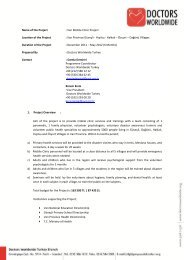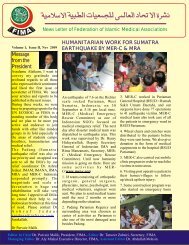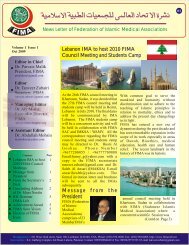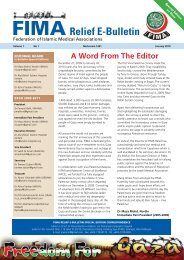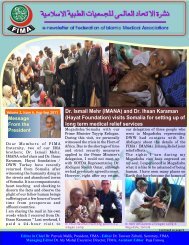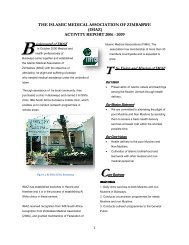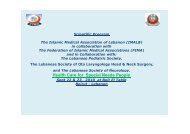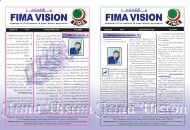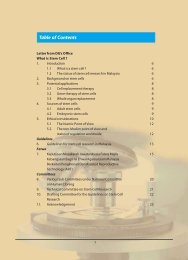FIMA Year Book 2009 - Federation of Islamic Medical Associations
FIMA Year Book 2009 - Federation of Islamic Medical Associations
FIMA Year Book 2009 - Federation of Islamic Medical Associations
Create successful ePaper yourself
Turn your PDF publications into a flip-book with our unique Google optimized e-Paper software.
Clinicians As Effective ResearchersFinancial SupportDeveloped countries have recognizedthat support for research anddevelopment pays rich dividends inthe long run. The amount invested inresearch and development in Japanis 2.9% <strong>of</strong> the gross domestic product(GDP). In the United States and Europe,it averages between 1.5% and 3% <strong>of</strong> theGDP. The Southeast Asian countriesaverage 0.89% <strong>of</strong> their GDP, and in theArab countries it averages only 0.23%<strong>of</strong> the GDP, with the exception <strong>of</strong> Qatar,where the percentage is 2.8%. Thesenumbers translate to $19 per personin Saudi Arabia, $665 per person inthe United States, and $649 per personin Japan. In developed countries, theprivate sector plays a major role insupporting research and development.For example in the United States, thegovernment provides the NIH with anannual budget <strong>of</strong> around $28 billion,whereas the private sector supportfor research in the United States isestimated to be double that amount.A good example <strong>of</strong> the rich returnsfor research investment are evidentwith the recent epidemic <strong>of</strong> HIV/AIDS, which, in the mid 1980s, had notreatment and had a very high mortalityrate. If this trend had continued, it isestimated that in the United States wewould have more than 200,000 hospitalbeds occupied by AIDS patients.Thankfully, with an investment <strong>of</strong> $10billion dollars over 10 years the viruswas identified, drugs were discovered,and the treatment <strong>of</strong> this deadly diseasechanged from inpatient treatment tooutpatient long-term care. Thus the $10billion investment saved $1.4 trillion inhealth-care costs, or a 1:140 return (11) .SummaryBased on the author’s personalexperience as a clinical researcherand having overseen the expandingresearch at KFMC since 2007, wherethe submissions <strong>of</strong> research proposalshave grown from 27 in 2007 to 62 in2008. Submissions are projected toreach close to 100 in <strong>2009</strong>. The keyfactors for success in research areintellectual curiosity; asking the keyquestions; “but why,” persistence; followup to test hypotheses; honesty andintegrity in collecting data; reportingall findings, both the expected and theunexpected; assessing what is availableand doable in the place you work, asthere is no point in doing researchin transplantation if your institutiondoes not have a transplant program;and most <strong>of</strong> all, learning to collaborateand cooperate. On top <strong>of</strong> that, there isan element <strong>of</strong> luck involved, being inthe right environment, having accessto role models, and having a helpfulmentor and cooperative peers.Follow UpAll <strong>of</strong> the good work is <strong>of</strong> little value ifit does not get presented or publishedso the results <strong>of</strong> the investigators’ workcan be shared with a larger community.Here are a few suggestions in getting thematerial published: The qualities <strong>of</strong> themanuscript and the journal must match;<strong>FIMA</strong> <strong>Year</strong><strong>Book</strong> <strong>2009</strong>134




